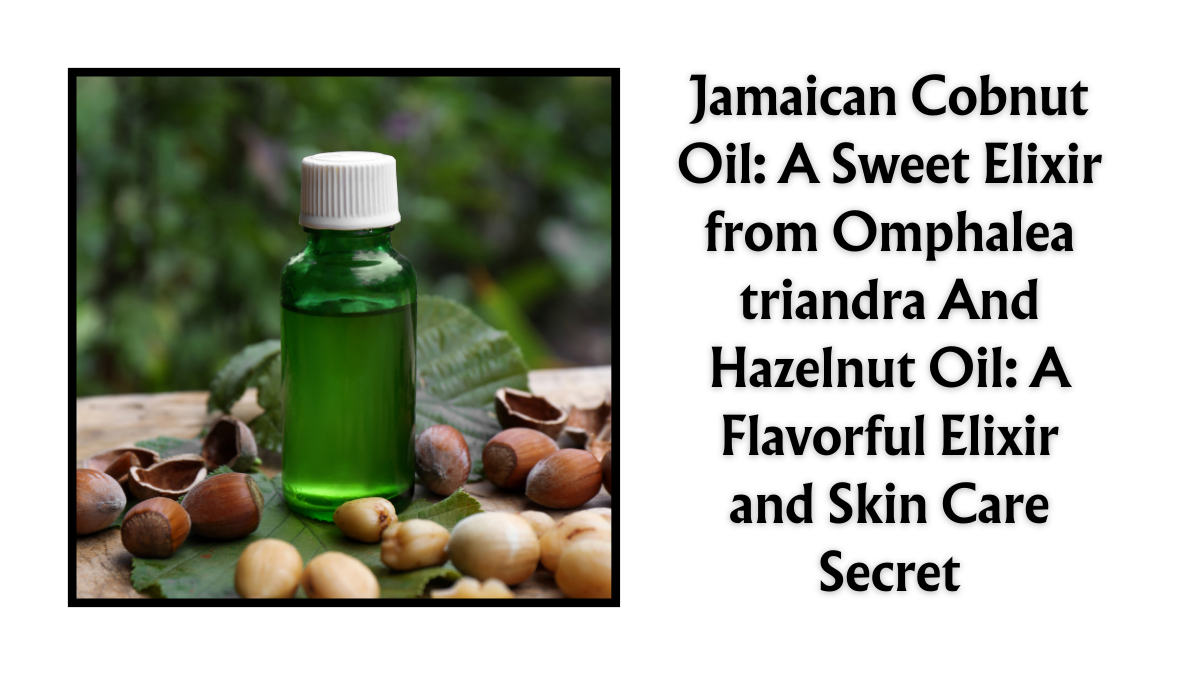Jamaican Cobnut Oil: A Sweet Elixir from Omphalea triandra And Hazelnut Oil: A Flavorful Elixir and Skin Care Secret
Explore the luscious world of nutty elixirs with our spotlight on Jamaican Cobnut Oil and Hazelnut Oil. Jamaican Cobnut Oil, derived from the seeds of Omphalea triandra, offers a sweet and aromatic essence that tantalizes the senses. Delve into its unique flavor profile and discover the diverse culinary and skincare applications that make it a cherished elixir.
Hazelnut Oil, on the other hand, unveils a flavorful experience that goes beyond the kitchen. Extracted from hazelnuts, it not only adds a delightful taste to your dishes but also serves as a hidden secret in skincare. Uncover the dual nature of Hazelnut Oil as a culinary gem and a skincare ally, providing you with both taste and nourishment. Elevate your culinary adventures and skincare rituals with these two exceptional oils, each offering a distinct essence of indulgence and care.

Jamaican Cobnut Oil: A Sweet Elixir from Omphalea Triandra
Introduction
Jamaican cobnut oil, extracted from the seeds of Omphalea triandra, is a unique and versatile oil with a sweet, fine flavor. Native to the tropical Americas, this oil holds cultural significance in Jamaica and is not only used in culinary applications but also finds utility as a lubricant. In this article, we will explore the characteristics, culinary uses, and additional applications of Jamaican cobnut oil.
Characteristics of Jamaican Cobnut Oil
1. Sweet Flavor Profile
– Jamaican cobnut oil is known for its distinctive sweet flavor, making it a sought-after ingredient in culinary preparations. The unique taste adds depth and richness to a variety of dishes.
2. Fine Textural Quality
– The fine-textured nature of Jamaican cobnut oil contributes to its versatility in cooking. It can be easily incorporated into recipes without overpowering the other flavors.
Culinary Uses of Jamaican Cobnut Oil
1. Cooking and Sautéing
– Utilize Jamaican cobnut oil in cooking and sautéing. Its sweet and fine flavor profile can enhance the taste of both savory and sweet dishes.
2. Dressings and Marinades
– Create flavorful dressings and marinades by incorporating Jamaican cobnut oil. Its unique sweetness can add a delightful twist to salads and marinated dishes.
3. Baking and Desserts
– Explore the use of Jamaican cobnut oil in baking and dessert recipes. Its sweet notes can complement the flavors of cakes, pastries, and other confections.

Beyond Culinary: Jamaican Cobnut Oil as a Lubricant
1. Traditional Lubricant Usage
– In addition to its culinary applications, Jamaican cobnut oil has been reported to be used traditionally as a lubricant. The oil’s natural properties may make it suitable for certain lubricating purposes.
Considerations for Jamaican Cobnut Oil Usage
1. Storage
– Store Jamaican cobnut oil in a cool, dark place to maintain its flavor and nutritional properties. Ensure the container is sealed tightly to prevent oxidation.
2. Culinary Experimentation
– Due to its unique flavor profile, consider experimenting with Jamaican cobnut oil in various recipes. Its sweet and fine qualities make it a versatile ingredient in both traditional and innovative dishes.
Conclusion
Jamaican cobnut oil, with its sweet and fine flavor, brings a unique touch to the culinary landscape of the tropical Americas. From enhancing the taste of savory dishes to adding richness to desserts, this oil holds cultural significance in Jamaican cuisine. Additionally, its traditional usage as a lubricant showcases the diverse applications of this natural elixir.
Note: Always ensure that the Jamaican cobnut oil you acquire is produced and sourced responsibly, considering ethical and environmental considerations.
FAQs:
1. Can Jamaican cobnut oil be used in both savory and sweet dishes?
– Yes, Jamaican cobnut oil’s sweet and fine flavor profile makes it suitable for a wide range of culinary applications, including both savory and sweet dishes.
2. Is Jamaican cobnut oil readily available outside of Jamaica?
– Availability may vary, but specialty stores, online platforms, or local markets with a focus on diverse and international ingredients may carry Jamaican cobnut oil.
3. How is Jamaican cobnut oil traditionally used as a lubricant?
– The traditional use of Jamaican cobnut oil as a lubricant might be specific to certain cultural practices or traditional applications. Details about its lubricating uses may require further cultural or historical exploration.
Hazelnut Oil: A Flavorful Elixir and Skin Care Secret
Introduction
Hazelnut oil, derived from the seeds of hazelnuts, is prized for its delightful flavor and versatile applications. Beyond culinary uses, its slight astringent nature makes it a popular choice in skincare. In this article, we’ll explore the flavor profile, culinary uses, and skincare benefits of hazelnut oil.

Hazelnut Oil in Culinary Creations
1. Rich, Nutty Flavor
– Hazelnut oil is renowned for its rich and nutty flavor, making it a sought-after ingredient in culinary creations. Its unique taste adds depth to both savory and sweet dishes.
2. Salad Dressings and Marinades
– Use hazelnut oil as a key component in salad dressings and marinades. Its distinctive flavor can elevate the taste of fresh greens, vegetables, and marinated proteins.
3. Baking and Desserts
– Incorporate hazelnut oil into baking and dessert recipes. From cakes to pastries, its nutty notes complement a variety of sweet treats.
Hazelnut Oil in Skincare
1. Slight Astringent Nature
– Hazelnut oil’s slight astringency makes it a popular choice in skincare. It is often used in facial oils, cleansers, and moisturizers due to its ability to tone and tighten the skin without causing excessive dryness.
2. Balancing Oily Skin
– Hazelnut oil is suitable for various skin types, including oily and acne-prone skin. Its astringent properties help balance oil production, making it an effective choice for those with combination skin.
3. Moisturizing and Nourishing
– Despite its astringency, hazelnut oil is still moisturizing and nourishing. It absorbs well into the skin without leaving a greasy residue, making it a valuable addition to skincare routines.
Considerations for Hazelnut Oil Usage
1. Quality Matters
– Choose high-quality, cold-pressed hazelnut oil for both culinary and skincare purposes. Cold-pressing helps retain the oil’s natural flavor and beneficial properties.
2. Patch Test in Skincare
– Before applying hazelnut oil to the skin, conduct a patch test to ensure there are no adverse reactions. While it’s generally well-tolerated, individual skin sensitivities can vary.
Conclusion
Hazelnut oil, with its rich flavor and versatile applications, is a gem in both the kitchen and the beauty routine. Whether adding a nutty touch to your favorite recipes or incorporating its astringent benefits into your skincare regimen, hazelnut oil brings a touch of indulgence to various aspects of daily life.
FAQs:
1. Can hazelnut oil be used for cooking at high temperatures?
– Hazelnut oil has a moderate smoke point, so it is best suited for low to medium-heat cooking. For high-heat applications, consider using oils with higher smoke points.
2. Is hazelnut oil comedogenic?
– Hazelnut oil is considered non-comedogenic, meaning it is unlikely to clog pores. This makes it a suitable choice for those with acne-prone or oily skin.
3. Can hazelnut oil be used on sensitive skin?
– Hazelnut oil is generally well-tolerated, but individuals with sensitive skin should perform a patch test before using it more extensively. If irritation occurs, discontinue use and consult with a skincare professional.






